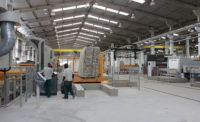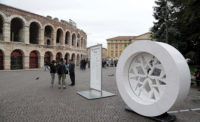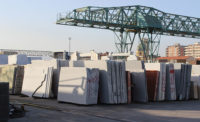
Standing as a distinctive piece of architecture, the El Taj Oceanfront in Playa del Carmen, Mexico, has been a proud achievement for the city it occupies. Not only are mostly local materials used throughout, the condominium/hotel project features work from architect Sergio Segura - a native to the area. In his design, Segura chose to use stone wherever it was possible. “Everywhere we can use stone, we used it,” he said.
By using local materials, Segura explained that he wanted guests who are not from the area to understand that they are in a place with its own unique culture. Just steps away from the ocean, the existing tropical landscape provided a stepping-stone for Segura’s design.
“The goal was to create a unique piece of architecture,” he said. “People can feel something different and special. This style is a combination of Mexican and sea architecture, which are results of the weather and geography of [Playa del Carmen].”

Because of Segura’s love for natural stone, he chose to apply the material in a broad range of applications at the El Taj Oceanfront, including the flooring and counters throughout as well as walls, baseboards, terraces and roofs, and planters and baseboards around the building. “Stone is fantastic when you use it,” he said. “It was a nice challenge to find the right materials and combine them.”
The luxury establishment is comprised of apartments where residents can enjoy the amenities of a high-end hotel. For all of the floors inside the apartments, as well as for the bathroom walls, Segura selected Crema Maya, a soft, local marble with a light beige color. Cream-colored granite countertops complement the floors and complete the look of the bathrooms and kitchens throughout.

Segura further used black river stone for detailing areas inside, such as trims around the beds, to make “carpets,” for medallions and for the floor of the showers. “It feels very good on your feet when you take a shower,” said the architect.

The
recent construction of the El Taj Oceanfront in Playa del Carmen, Mexico, uses
local stone throughout, helping achieve the essence of the area. In his design,
Sergio Segura, the architect for the condominium/hotel project, chose
cream-colored granite countertops in all of the kitchens and Crema Maya, a
soft, local marble with a light beige color for all of the floors inside the
apartments. Additionally, a fossil stone - which has shells and other embedded
relics - was employed for some of the walls in the living rooms. The various
marble pieces protrude from the wall in a random pattern, creating a unique
effect. Architect: Sergio Segura, Playa del Carmen, Mexico
For the exterior design, slate from Bali brings character to some of the walls and planters as well as a backsplash for a barbecue kitchen that is located on the roof of the complex. Segura explained that although the majority of the materials were local due to being well conditioned for Mexico’s weather and the importance it represents for the culture, consideration had been given to the materials imported from Bali. “Bali is parallel to Ecuador [a close neighbor to Mexico], so we felt we were allowed to bring some things from there because they are part of our culture,” he said, adding that several of the sinks also came from Bali.
Additional exterior stone architecture includes Aticato marble, another local material, which was employed for all of the terraces and roof areas. “It’s basically the same color as the interior, but with a non-slip finish because of the rain and any possibility of it getting wet,” said Segura.

The
palette of marble and fossil stone was also carried into the master bedrooms,
including the use of three-dimensional patterning on the walls.
While the majority of stone floor tiles throughout the hotel’s interior and exterior measure 24 x 24 inches, much of the wall tiles are 12- x 12-inch in size, in addition to random small pieces and irregular “egg shapes” for the river stone.

For
other exterior areas, Aticato marble, another local material, comprises all of
the terraces and roof areas. “It’s basically the same color as the interior,
but with a non-slippery finish because of the rain and any possibility of it
getting wet,” said Segura.
Segura explained that the client was very much involved in the selection process. “He has good taste and is very enthusiastic,” he said. “He’s a very good client that’s also very involved in the construction.”
Besides finding the right combination of different stone materials, Segura explained there was a concern with making sure they had the right people to install the product. “We had to teach the people to [install] the stone the right way,” he said, adding that he and the client were there everyday taking care of the details and ensuring quality.

The
outdoor central patio, also known as the sanctuary, features a floor made of
local fossil stone.


